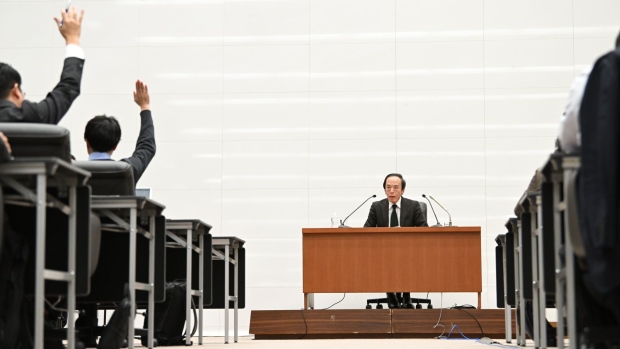Mar 19, 2024
How Bank of Japan’s Ueda Dismantled World’s Last Negative Rate
, Bloomberg News

(Bloomberg) -- When Kazuo Ueda emerged as the front runner to be the next governor of the Bank of Japan early last year, former Treasury Secretary Larry Summers described the septuagenarian academic as the Asian nation’s version of Ben Bernanke.
Both had studied at the Massachusetts Institute of Technology, Summers noted, and both shared a soft-spoken academic air but were “capable of being decisive.”
That resolve was on display Tuesday, when Ueda raised borrowing costs for the first time since 2007, ending the era of negative interest rates and dismantling his predecessor’s yield curve control program in the process.
It’s a move that was deemed unlikely to be achievable this soon by most market players when Ueda, now 72, took the helm as the first academic in the institution’s 141-year long history back in April.
Yet at eight policy meetings as BOJ chief, Ueda has now adjusted policy or forward guidance four times, with Tuesday’s shift the most consequential by far. It’s a track record that suggests investors ought to brace for more change as Japan claws its way out of more than a decade of deflation and back toward monetary policy orthodoxy.
“The monetary policy framework that Ueda is aiming for is an extremely traditional one with the combination of very low interest rates and forward guidance,” said Hideo Hayakawa, former BOJ executive director who has known the governor for more than four decades.
Early in his tenure, Bernanke would begin slashing US interest rates and go on to lead the Fed into a massive quantitative easing campaign in response to the 2007-08 financial crisis. Not even a year into his governorship, Ueda faces the opposite challenge: To extricate Japan from the world’s boldest monetary experiment.
Here’s a look at how Ueda’s done so far:
As soon as his nomination was reported in February 2023, Ueda signaled an intention to communicate clearly and move methodically. That was seen as a departure from his predecessor Haruhiko Kuroda, who gained a reputation for surprising markets with “shock and awe” policy moves.
Ueda began his term dovishly, sticking to the script of Kuroda’s staunch easing stance, spurring economists to push back forecasts for tightening. He also sought to lower expectations — in contrast to his predecessor’s bold debut.
“My mission isn’t to come up with some kind of magical, special monetary policy,” Ueda said during parliamentary hearings to confirm his nomination. Kuroda, by contrast, began his governorship declaring his goal to achieve the 2% inflation target in just a couple of years.
At Ueda’s first policy meeting as governor in April, he pulled off the first of his surprises by ditching a clear bias toward monetary easing. The nation’s key inflation measure at the time was hovering around 3%, well above the BOJ’s 2% target.
Ueda next caught markets off guard in July when he adjusted the yield curve control program by expanding the range for 10-year bond yields. Yet even after that move, nearly two thirds of BOJ watchers viewed Ueda’s communication favorably. At that time, only 4% forecast the end of the negative rate by March this year.
At the October meeting, Ueda gave himself more flexibility on the YCC framework in a move that essentially turned it into an insurance policy against a surge in bond yields rather than an actual target band.
The framework tweaks helped ensure that the eventual axing of YCC this week didn’t cause the kind of messy capitulation seen when the Reserve Bank of Australia backed away from its own version of the policy.
At the December meeting, Ueda downplayed chances of an immediate interest rate hike, saying he wanted more evidence the price stability target was in sight. Come January, the bank’s quarterly report stated for the first time under his watch that the certainty of achieving the BOJ’s projections had continued to gradually increase.
In the run up to Tuesday’s meeting, Ueda had repeatedly noted the importance of spring wage talks. So when the nation’s largest union group announced first-round results to annual wage negotiations that far exceeded expectations late Friday, bets quickly shifted to a move.
With negative interest rates now in Japan’s rear-view mirror, attention is quickly shifting to how soon the next rate increase will follow and what Ueda will do with the stockpile of assets his predecessors accumulated.
“Ueda has done better than Bernanke so far without triggering something equivalent to a taper tantrum,” said Hiroshi Miyazaki, senior economist at Mizuho Research & Technologies. “Still, it’s not over yet. There are a mountain of tasks ahead of him.”
©2024 Bloomberg L.P.






